Public Health and Safety: Chronic Disease, Environmental Health Cases
VerifiedAdded on 2021/09/15
|9
|1921
|63
Report
AI Summary
This report presents an analysis of public health issues, focusing on chronic disease prevention, environmental health, and occupational health. The first section evaluates the challenges of implementing obesity prevention programs in a resource-poor rural area, considering socioeconomic factors and ethical implications. The second section examines a case study involving a medical student with MRSA, discussing the ethical considerations of excluding healthcare workers with MRSA colonization and recommending universal screening. The final section addresses water quality concerns, analyzing the ethical implications of disclosing test results, and recommending strategies for water safety and risk management, considering the WHO guidelines. The report emphasizes the importance of community-based interventions, health equity, and transparency in public health practices.
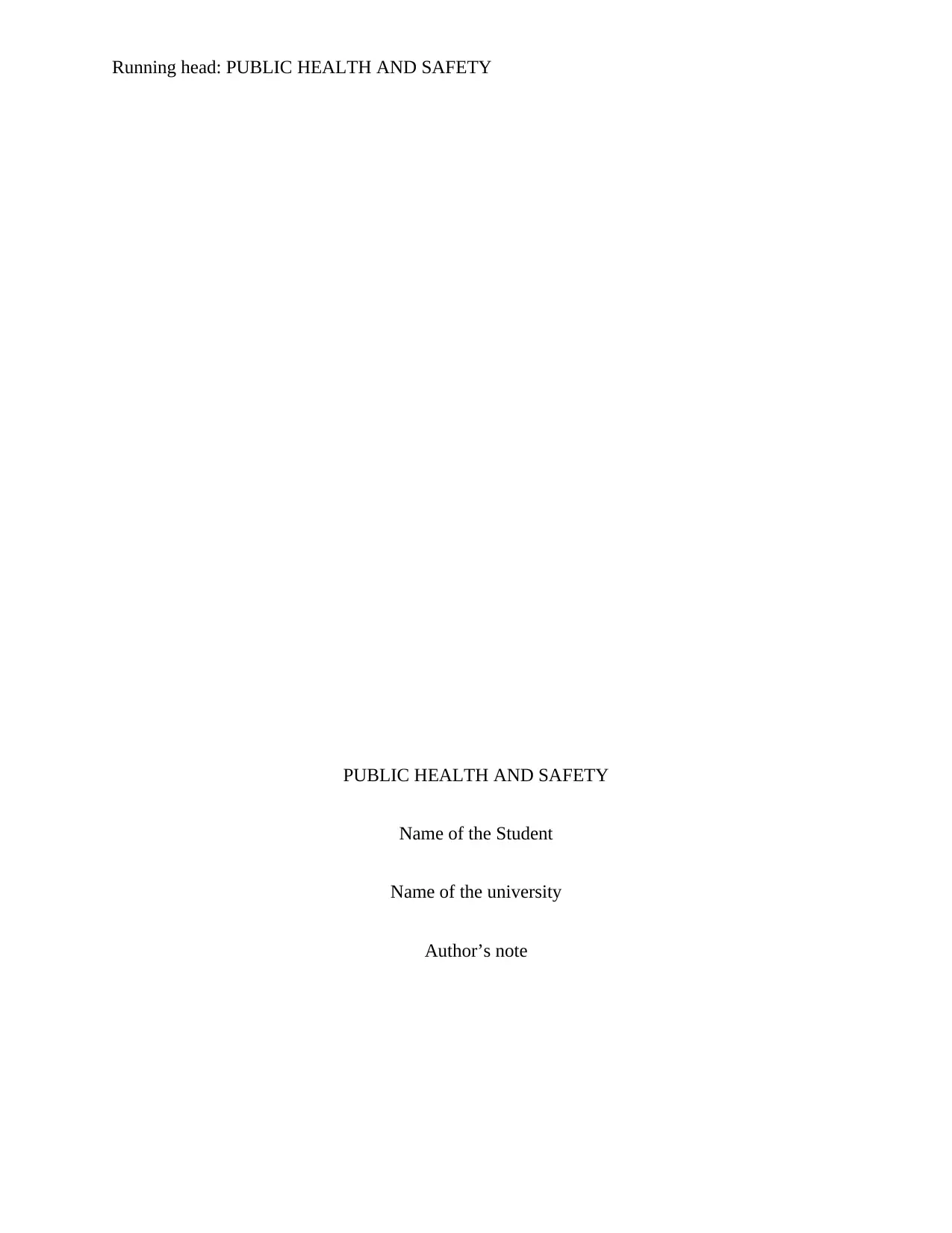
Running head: PUBLIC HEALTH AND SAFETY
PUBLIC HEALTH AND SAFETY
Name of the Student
Name of the university
Author’s note
PUBLIC HEALTH AND SAFETY
Name of the Student
Name of the university
Author’s note
Paraphrase This Document
Need a fresh take? Get an instant paraphrase of this document with our AI Paraphraser
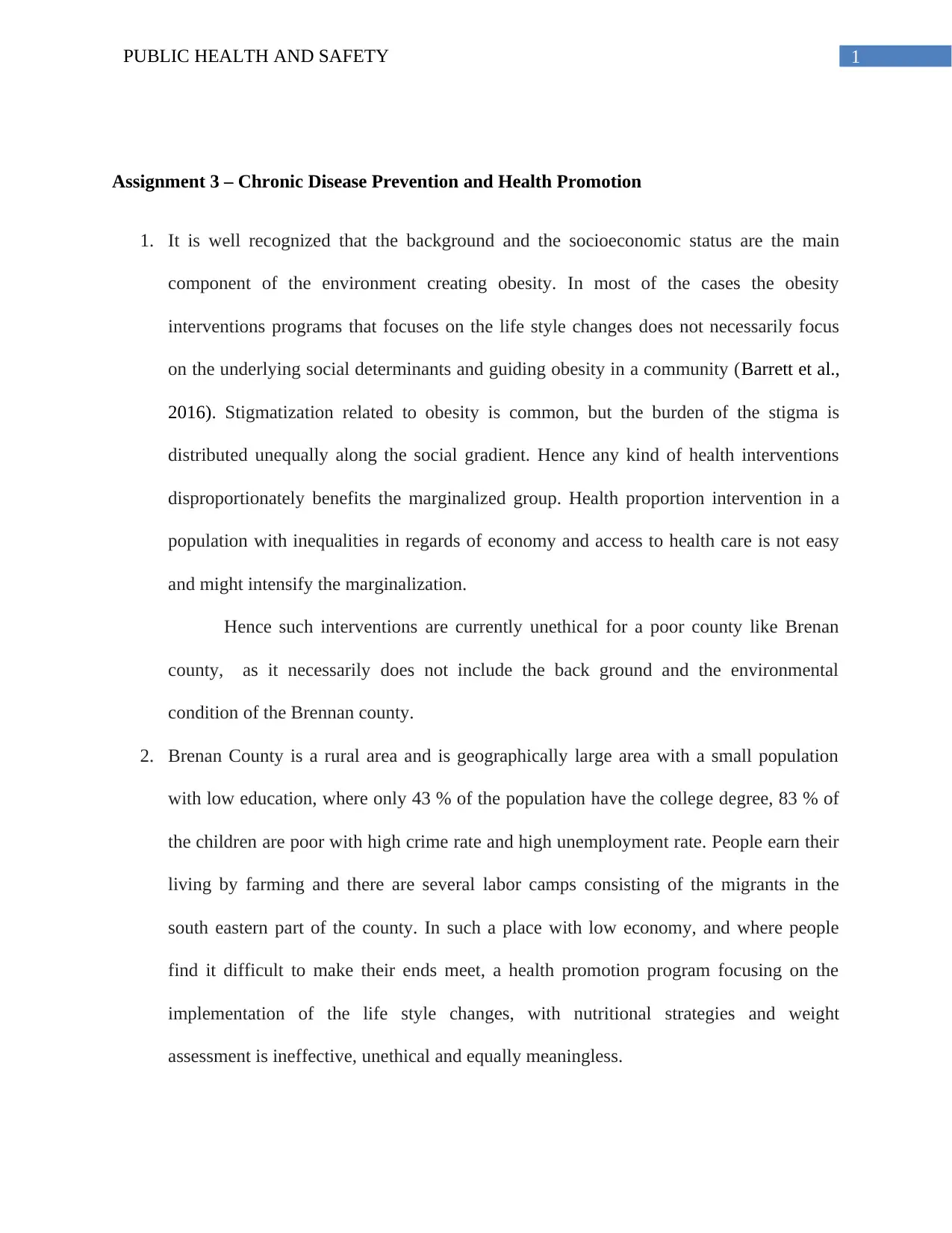
1PUBLIC HEALTH AND SAFETY
Assignment 3 – Chronic Disease Prevention and Health Promotion
1. It is well recognized that the background and the socioeconomic status are the main
component of the environment creating obesity. In most of the cases the obesity
interventions programs that focuses on the life style changes does not necessarily focus
on the underlying social determinants and guiding obesity in a community (Barrett et al.,
2016). Stigmatization related to obesity is common, but the burden of the stigma is
distributed unequally along the social gradient. Hence any kind of health interventions
disproportionately benefits the marginalized group. Health proportion intervention in a
population with inequalities in regards of economy and access to health care is not easy
and might intensify the marginalization.
Hence such interventions are currently unethical for a poor county like Brenan
county, as it necessarily does not include the back ground and the environmental
condition of the Brennan county.
2. Brenan County is a rural area and is geographically large area with a small population
with low education, where only 43 % of the population have the college degree, 83 % of
the children are poor with high crime rate and high unemployment rate. People earn their
living by farming and there are several labor camps consisting of the migrants in the
south eastern part of the county. In such a place with low economy, and where people
find it difficult to make their ends meet, a health promotion program focusing on the
implementation of the life style changes, with nutritional strategies and weight
assessment is ineffective, unethical and equally meaningless.
Assignment 3 – Chronic Disease Prevention and Health Promotion
1. It is well recognized that the background and the socioeconomic status are the main
component of the environment creating obesity. In most of the cases the obesity
interventions programs that focuses on the life style changes does not necessarily focus
on the underlying social determinants and guiding obesity in a community (Barrett et al.,
2016). Stigmatization related to obesity is common, but the burden of the stigma is
distributed unequally along the social gradient. Hence any kind of health interventions
disproportionately benefits the marginalized group. Health proportion intervention in a
population with inequalities in regards of economy and access to health care is not easy
and might intensify the marginalization.
Hence such interventions are currently unethical for a poor county like Brenan
county, as it necessarily does not include the back ground and the environmental
condition of the Brennan county.
2. Brenan County is a rural area and is geographically large area with a small population
with low education, where only 43 % of the population have the college degree, 83 % of
the children are poor with high crime rate and high unemployment rate. People earn their
living by farming and there are several labor camps consisting of the migrants in the
south eastern part of the county. In such a place with low economy, and where people
find it difficult to make their ends meet, a health promotion program focusing on the
implementation of the life style changes, with nutritional strategies and weight
assessment is ineffective, unethical and equally meaningless.
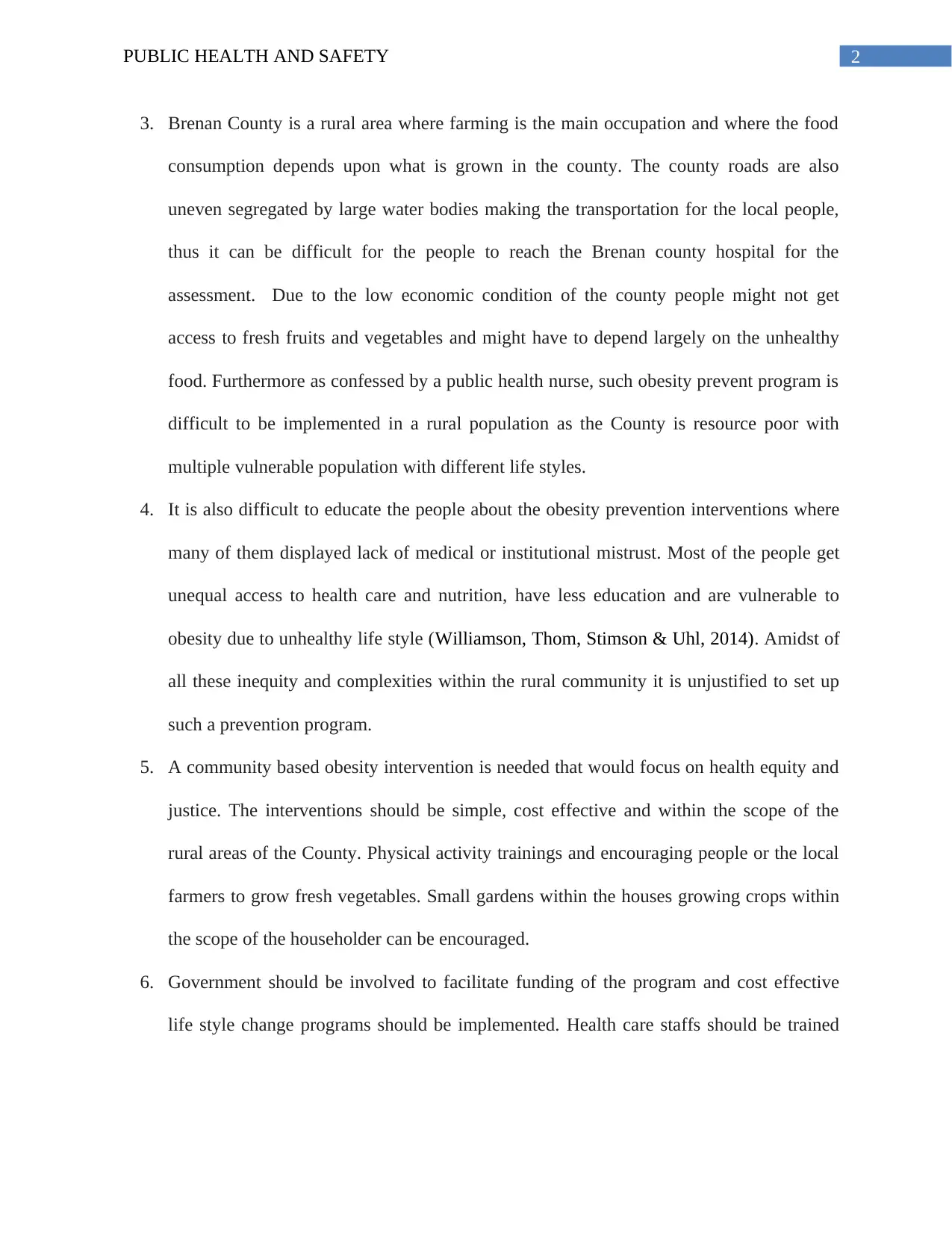
2PUBLIC HEALTH AND SAFETY
3. Brenan County is a rural area where farming is the main occupation and where the food
consumption depends upon what is grown in the county. The county roads are also
uneven segregated by large water bodies making the transportation for the local people,
thus it can be difficult for the people to reach the Brenan county hospital for the
assessment. Due to the low economic condition of the county people might not get
access to fresh fruits and vegetables and might have to depend largely on the unhealthy
food. Furthermore as confessed by a public health nurse, such obesity prevent program is
difficult to be implemented in a rural population as the County is resource poor with
multiple vulnerable population with different life styles.
4. It is also difficult to educate the people about the obesity prevention interventions where
many of them displayed lack of medical or institutional mistrust. Most of the people get
unequal access to health care and nutrition, have less education and are vulnerable to
obesity due to unhealthy life style (Williamson, Thom, Stimson & Uhl, 2014). Amidst of
all these inequity and complexities within the rural community it is unjustified to set up
such a prevention program.
5. A community based obesity intervention is needed that would focus on health equity and
justice. The interventions should be simple, cost effective and within the scope of the
rural areas of the County. Physical activity trainings and encouraging people or the local
farmers to grow fresh vegetables. Small gardens within the houses growing crops within
the scope of the householder can be encouraged.
6. Government should be involved to facilitate funding of the program and cost effective
life style change programs should be implemented. Health care staffs should be trained
3. Brenan County is a rural area where farming is the main occupation and where the food
consumption depends upon what is grown in the county. The county roads are also
uneven segregated by large water bodies making the transportation for the local people,
thus it can be difficult for the people to reach the Brenan county hospital for the
assessment. Due to the low economic condition of the county people might not get
access to fresh fruits and vegetables and might have to depend largely on the unhealthy
food. Furthermore as confessed by a public health nurse, such obesity prevent program is
difficult to be implemented in a rural population as the County is resource poor with
multiple vulnerable population with different life styles.
4. It is also difficult to educate the people about the obesity prevention interventions where
many of them displayed lack of medical or institutional mistrust. Most of the people get
unequal access to health care and nutrition, have less education and are vulnerable to
obesity due to unhealthy life style (Williamson, Thom, Stimson & Uhl, 2014). Amidst of
all these inequity and complexities within the rural community it is unjustified to set up
such a prevention program.
5. A community based obesity intervention is needed that would focus on health equity and
justice. The interventions should be simple, cost effective and within the scope of the
rural areas of the County. Physical activity trainings and encouraging people or the local
farmers to grow fresh vegetables. Small gardens within the houses growing crops within
the scope of the householder can be encouraged.
6. Government should be involved to facilitate funding of the program and cost effective
life style change programs should be implemented. Health care staffs should be trained
⊘ This is a preview!⊘
Do you want full access?
Subscribe today to unlock all pages.

Trusted by 1+ million students worldwide
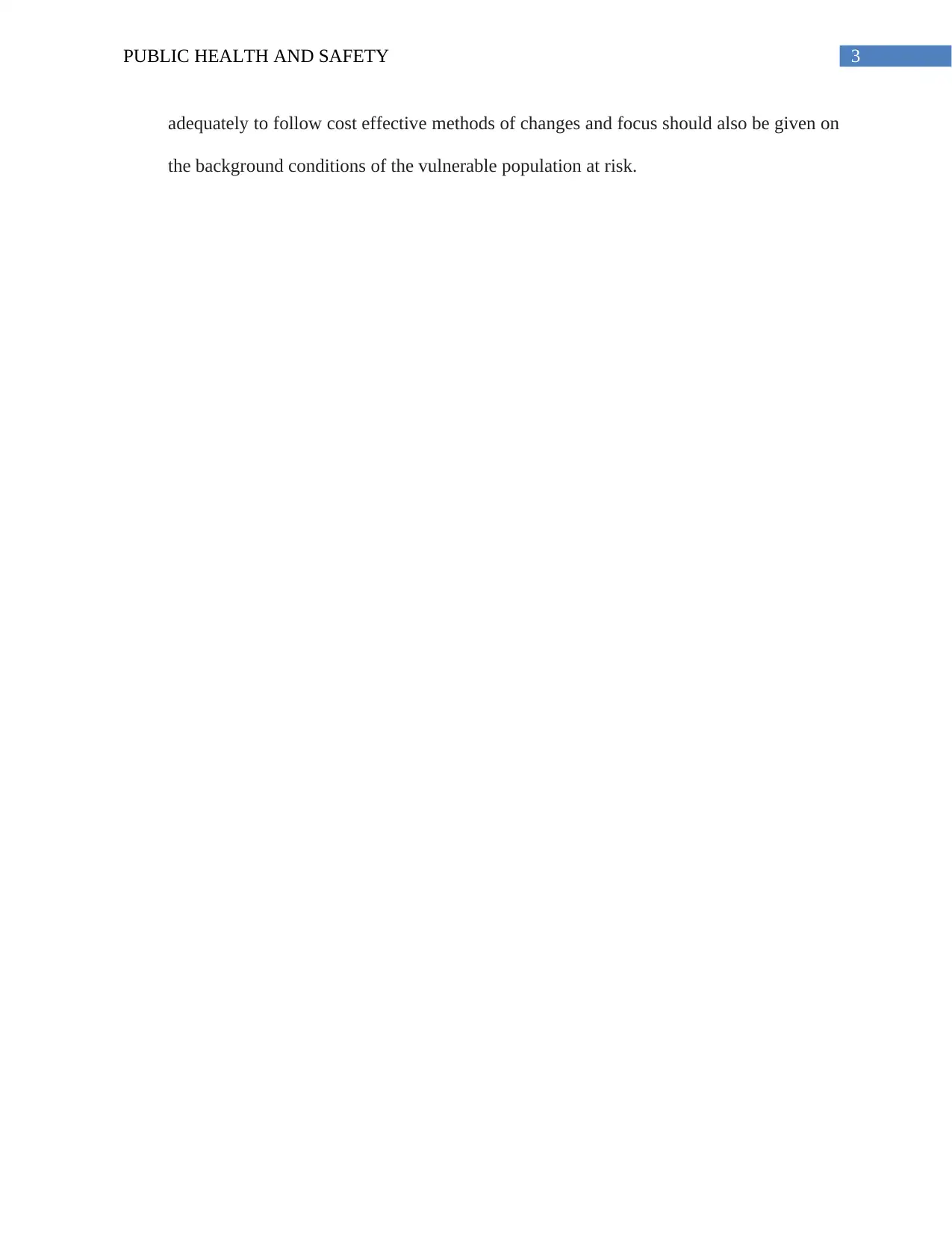
3PUBLIC HEALTH AND SAFETY
adequately to follow cost effective methods of changes and focus should also be given on
the background conditions of the vulnerable population at risk.
adequately to follow cost effective methods of changes and focus should also be given on
the background conditions of the vulnerable population at risk.
Paraphrase This Document
Need a fresh take? Get an instant paraphrase of this document with our AI Paraphraser
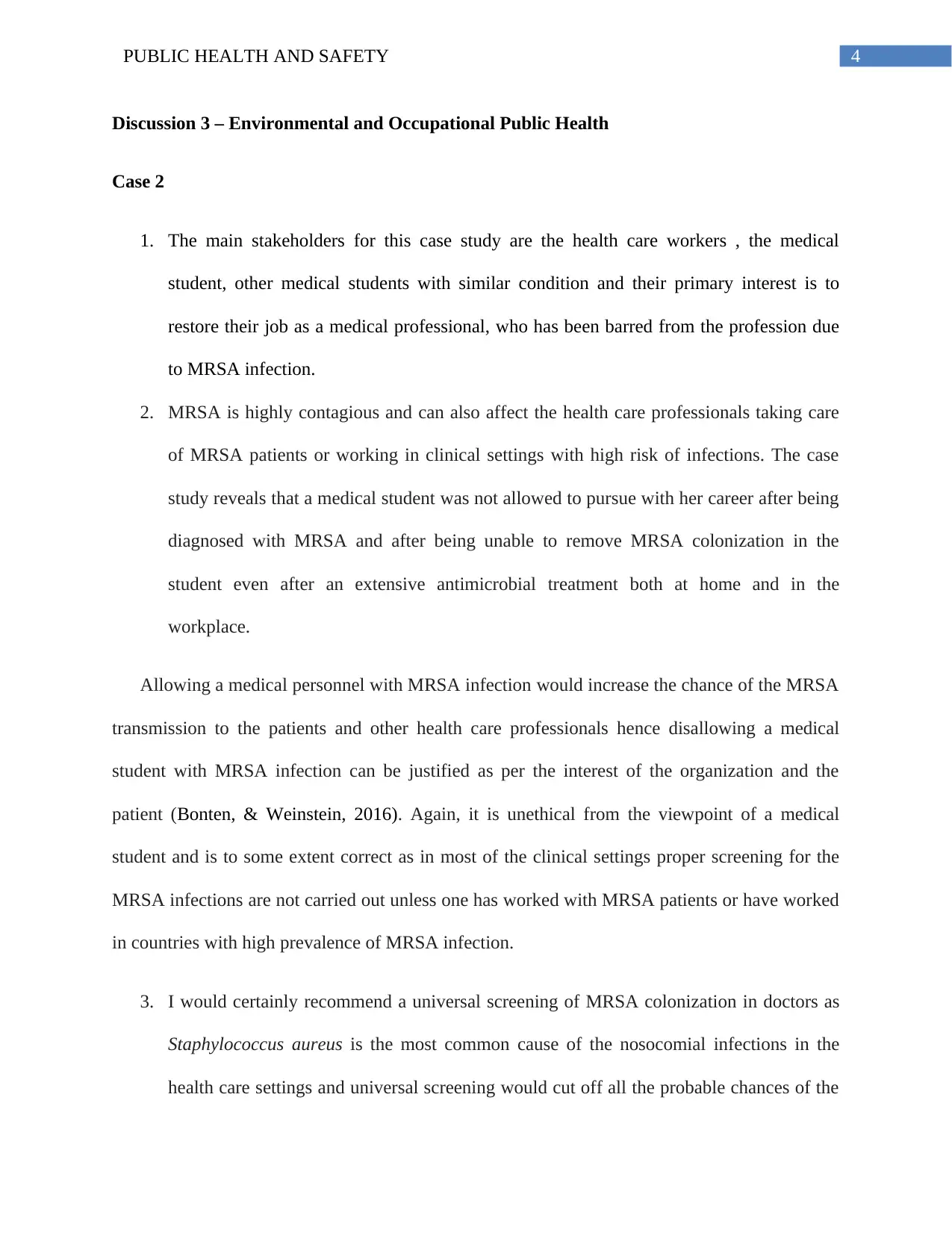
4PUBLIC HEALTH AND SAFETY
Discussion 3 – Environmental and Occupational Public Health
Case 2
1. The main stakeholders for this case study are the health care workers , the medical
student, other medical students with similar condition and their primary interest is to
restore their job as a medical professional, who has been barred from the profession due
to MRSA infection.
2. MRSA is highly contagious and can also affect the health care professionals taking care
of MRSA patients or working in clinical settings with high risk of infections. The case
study reveals that a medical student was not allowed to pursue with her career after being
diagnosed with MRSA and after being unable to remove MRSA colonization in the
student even after an extensive antimicrobial treatment both at home and in the
workplace.
Allowing a medical personnel with MRSA infection would increase the chance of the MRSA
transmission to the patients and other health care professionals hence disallowing a medical
student with MRSA infection can be justified as per the interest of the organization and the
patient (Bonten, & Weinstein, 2016). Again, it is unethical from the viewpoint of a medical
student and is to some extent correct as in most of the clinical settings proper screening for the
MRSA infections are not carried out unless one has worked with MRSA patients or have worked
in countries with high prevalence of MRSA infection.
3. I would certainly recommend a universal screening of MRSA colonization in doctors as
Staphylococcus aureus is the most common cause of the nosocomial infections in the
health care settings and universal screening would cut off all the probable chances of the
Discussion 3 – Environmental and Occupational Public Health
Case 2
1. The main stakeholders for this case study are the health care workers , the medical
student, other medical students with similar condition and their primary interest is to
restore their job as a medical professional, who has been barred from the profession due
to MRSA infection.
2. MRSA is highly contagious and can also affect the health care professionals taking care
of MRSA patients or working in clinical settings with high risk of infections. The case
study reveals that a medical student was not allowed to pursue with her career after being
diagnosed with MRSA and after being unable to remove MRSA colonization in the
student even after an extensive antimicrobial treatment both at home and in the
workplace.
Allowing a medical personnel with MRSA infection would increase the chance of the MRSA
transmission to the patients and other health care professionals hence disallowing a medical
student with MRSA infection can be justified as per the interest of the organization and the
patient (Bonten, & Weinstein, 2016). Again, it is unethical from the viewpoint of a medical
student and is to some extent correct as in most of the clinical settings proper screening for the
MRSA infections are not carried out unless one has worked with MRSA patients or have worked
in countries with high prevalence of MRSA infection.
3. I would certainly recommend a universal screening of MRSA colonization in doctors as
Staphylococcus aureus is the most common cause of the nosocomial infections in the
health care settings and universal screening would cut off all the probable chances of the
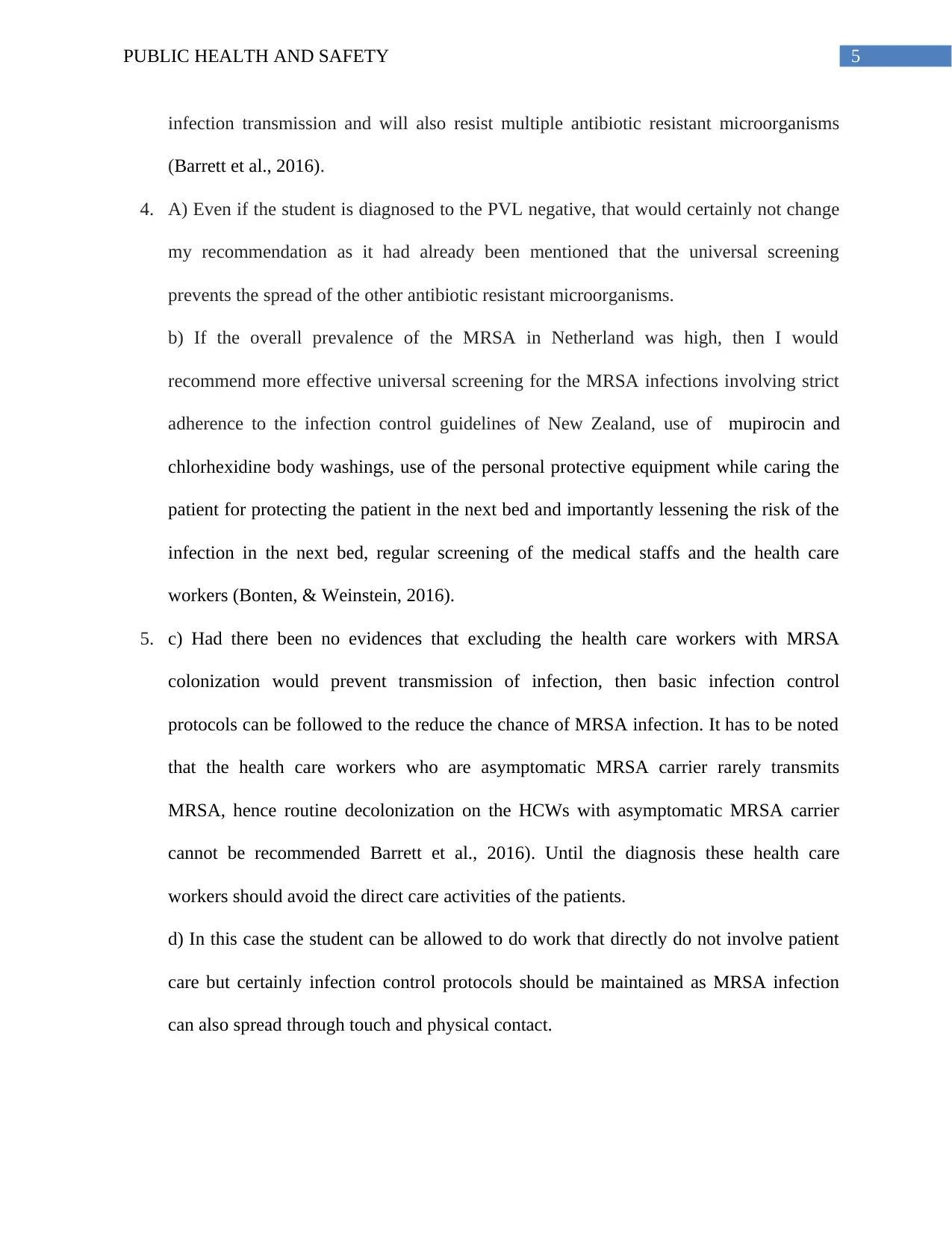
5PUBLIC HEALTH AND SAFETY
infection transmission and will also resist multiple antibiotic resistant microorganisms
(Barrett et al., 2016).
4. A) Even if the student is diagnosed to the PVL negative, that would certainly not change
my recommendation as it had already been mentioned that the universal screening
prevents the spread of the other antibiotic resistant microorganisms.
b) If the overall prevalence of the MRSA in Netherland was high, then I would
recommend more effective universal screening for the MRSA infections involving strict
adherence to the infection control guidelines of New Zealand, use of mupirocin and
chlorhexidine body washings, use of the personal protective equipment while caring the
patient for protecting the patient in the next bed and importantly lessening the risk of the
infection in the next bed, regular screening of the medical staffs and the health care
workers (Bonten, & Weinstein, 2016).
5. c) Had there been no evidences that excluding the health care workers with MRSA
colonization would prevent transmission of infection, then basic infection control
protocols can be followed to the reduce the chance of MRSA infection. It has to be noted
that the health care workers who are asymptomatic MRSA carrier rarely transmits
MRSA, hence routine decolonization on the HCWs with asymptomatic MRSA carrier
cannot be recommended Barrett et al., 2016). Until the diagnosis these health care
workers should avoid the direct care activities of the patients.
d) In this case the student can be allowed to do work that directly do not involve patient
care but certainly infection control protocols should be maintained as MRSA infection
can also spread through touch and physical contact.
infection transmission and will also resist multiple antibiotic resistant microorganisms
(Barrett et al., 2016).
4. A) Even if the student is diagnosed to the PVL negative, that would certainly not change
my recommendation as it had already been mentioned that the universal screening
prevents the spread of the other antibiotic resistant microorganisms.
b) If the overall prevalence of the MRSA in Netherland was high, then I would
recommend more effective universal screening for the MRSA infections involving strict
adherence to the infection control guidelines of New Zealand, use of mupirocin and
chlorhexidine body washings, use of the personal protective equipment while caring the
patient for protecting the patient in the next bed and importantly lessening the risk of the
infection in the next bed, regular screening of the medical staffs and the health care
workers (Bonten, & Weinstein, 2016).
5. c) Had there been no evidences that excluding the health care workers with MRSA
colonization would prevent transmission of infection, then basic infection control
protocols can be followed to the reduce the chance of MRSA infection. It has to be noted
that the health care workers who are asymptomatic MRSA carrier rarely transmits
MRSA, hence routine decolonization on the HCWs with asymptomatic MRSA carrier
cannot be recommended Barrett et al., 2016). Until the diagnosis these health care
workers should avoid the direct care activities of the patients.
d) In this case the student can be allowed to do work that directly do not involve patient
care but certainly infection control protocols should be maintained as MRSA infection
can also spread through touch and physical contact.
⊘ This is a preview!⊘
Do you want full access?
Subscribe today to unlock all pages.

Trusted by 1+ million students worldwide
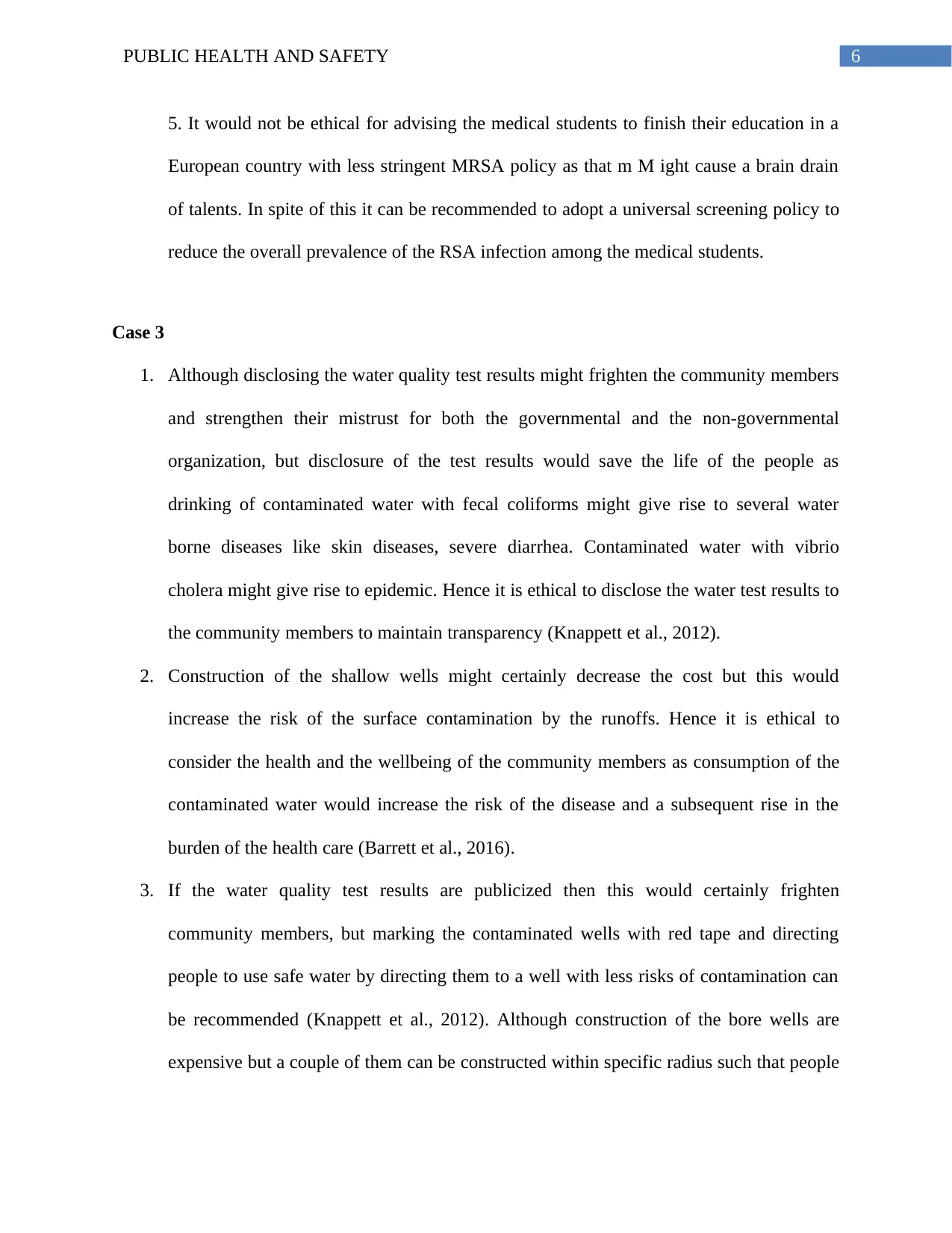
6PUBLIC HEALTH AND SAFETY
5. It would not be ethical for advising the medical students to finish their education in a
European country with less stringent MRSA policy as that m M ight cause a brain drain
of talents. In spite of this it can be recommended to adopt a universal screening policy to
reduce the overall prevalence of the RSA infection among the medical students.
Case 3
1. Although disclosing the water quality test results might frighten the community members
and strengthen their mistrust for both the governmental and the non-governmental
organization, but disclosure of the test results would save the life of the people as
drinking of contaminated water with fecal coliforms might give rise to several water
borne diseases like skin diseases, severe diarrhea. Contaminated water with vibrio
cholera might give rise to epidemic. Hence it is ethical to disclose the water test results to
the community members to maintain transparency (Knappett et al., 2012).
2. Construction of the shallow wells might certainly decrease the cost but this would
increase the risk of the surface contamination by the runoffs. Hence it is ethical to
consider the health and the wellbeing of the community members as consumption of the
contaminated water would increase the risk of the disease and a subsequent rise in the
burden of the health care (Barrett et al., 2016).
3. If the water quality test results are publicized then this would certainly frighten
community members, but marking the contaminated wells with red tape and directing
people to use safe water by directing them to a well with less risks of contamination can
be recommended (Knappett et al., 2012). Although construction of the bore wells are
expensive but a couple of them can be constructed within specific radius such that people
5. It would not be ethical for advising the medical students to finish their education in a
European country with less stringent MRSA policy as that m M ight cause a brain drain
of talents. In spite of this it can be recommended to adopt a universal screening policy to
reduce the overall prevalence of the RSA infection among the medical students.
Case 3
1. Although disclosing the water quality test results might frighten the community members
and strengthen their mistrust for both the governmental and the non-governmental
organization, but disclosure of the test results would save the life of the people as
drinking of contaminated water with fecal coliforms might give rise to several water
borne diseases like skin diseases, severe diarrhea. Contaminated water with vibrio
cholera might give rise to epidemic. Hence it is ethical to disclose the water test results to
the community members to maintain transparency (Knappett et al., 2012).
2. Construction of the shallow wells might certainly decrease the cost but this would
increase the risk of the surface contamination by the runoffs. Hence it is ethical to
consider the health and the wellbeing of the community members as consumption of the
contaminated water would increase the risk of the disease and a subsequent rise in the
burden of the health care (Barrett et al., 2016).
3. If the water quality test results are publicized then this would certainly frighten
community members, but marking the contaminated wells with red tape and directing
people to use safe water by directing them to a well with less risks of contamination can
be recommended (Knappett et al., 2012). Although construction of the bore wells are
expensive but a couple of them can be constructed within specific radius such that people
Paraphrase This Document
Need a fresh take? Get an instant paraphrase of this document with our AI Paraphraser
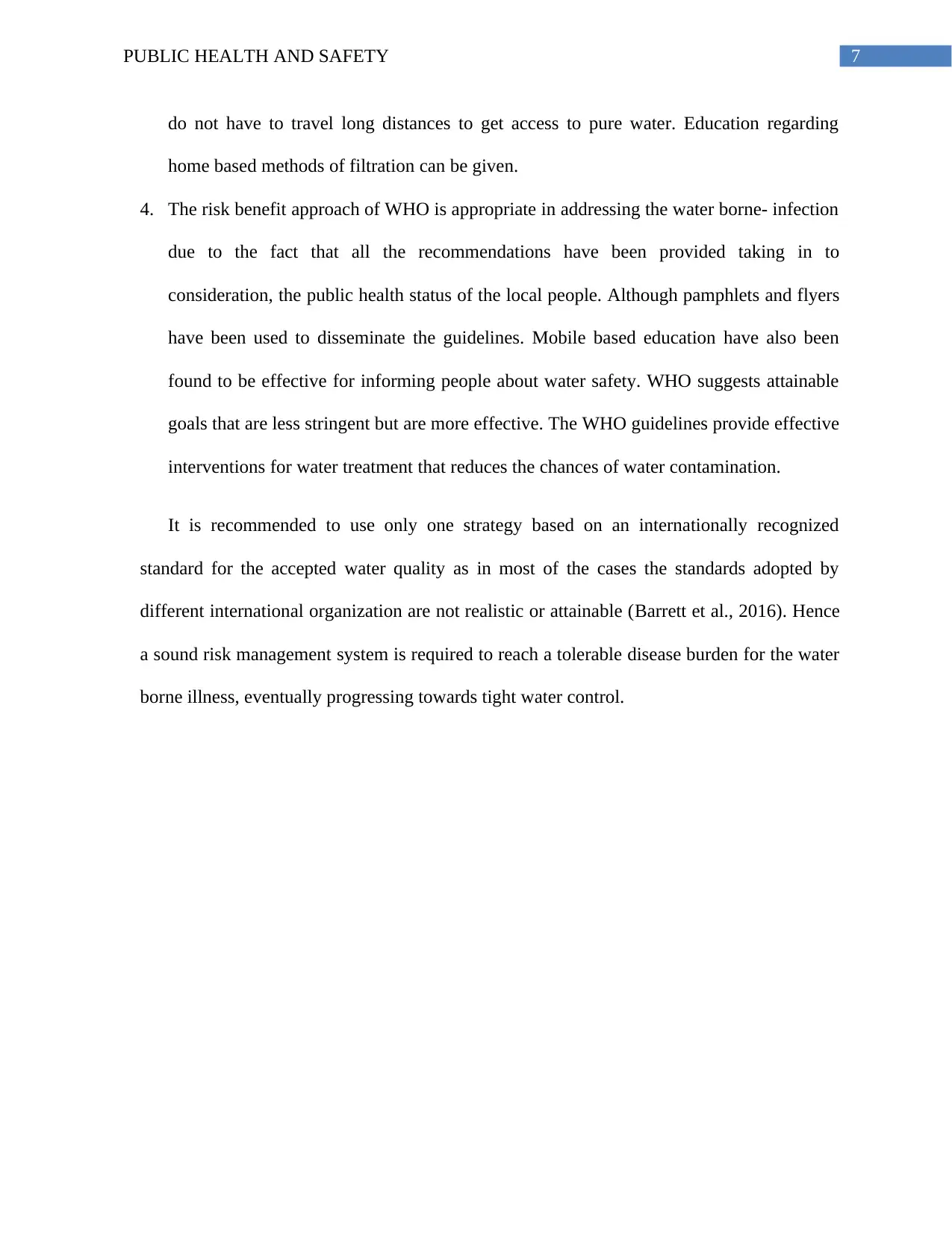
7PUBLIC HEALTH AND SAFETY
do not have to travel long distances to get access to pure water. Education regarding
home based methods of filtration can be given.
4. The risk benefit approach of WHO is appropriate in addressing the water borne- infection
due to the fact that all the recommendations have been provided taking in to
consideration, the public health status of the local people. Although pamphlets and flyers
have been used to disseminate the guidelines. Mobile based education have also been
found to be effective for informing people about water safety. WHO suggests attainable
goals that are less stringent but are more effective. The WHO guidelines provide effective
interventions for water treatment that reduces the chances of water contamination.
It is recommended to use only one strategy based on an internationally recognized
standard for the accepted water quality as in most of the cases the standards adopted by
different international organization are not realistic or attainable (Barrett et al., 2016). Hence
a sound risk management system is required to reach a tolerable disease burden for the water
borne illness, eventually progressing towards tight water control.
do not have to travel long distances to get access to pure water. Education regarding
home based methods of filtration can be given.
4. The risk benefit approach of WHO is appropriate in addressing the water borne- infection
due to the fact that all the recommendations have been provided taking in to
consideration, the public health status of the local people. Although pamphlets and flyers
have been used to disseminate the guidelines. Mobile based education have also been
found to be effective for informing people about water safety. WHO suggests attainable
goals that are less stringent but are more effective. The WHO guidelines provide effective
interventions for water treatment that reduces the chances of water contamination.
It is recommended to use only one strategy based on an internationally recognized
standard for the accepted water quality as in most of the cases the standards adopted by
different international organization are not realistic or attainable (Barrett et al., 2016). Hence
a sound risk management system is required to reach a tolerable disease burden for the water
borne illness, eventually progressing towards tight water control.
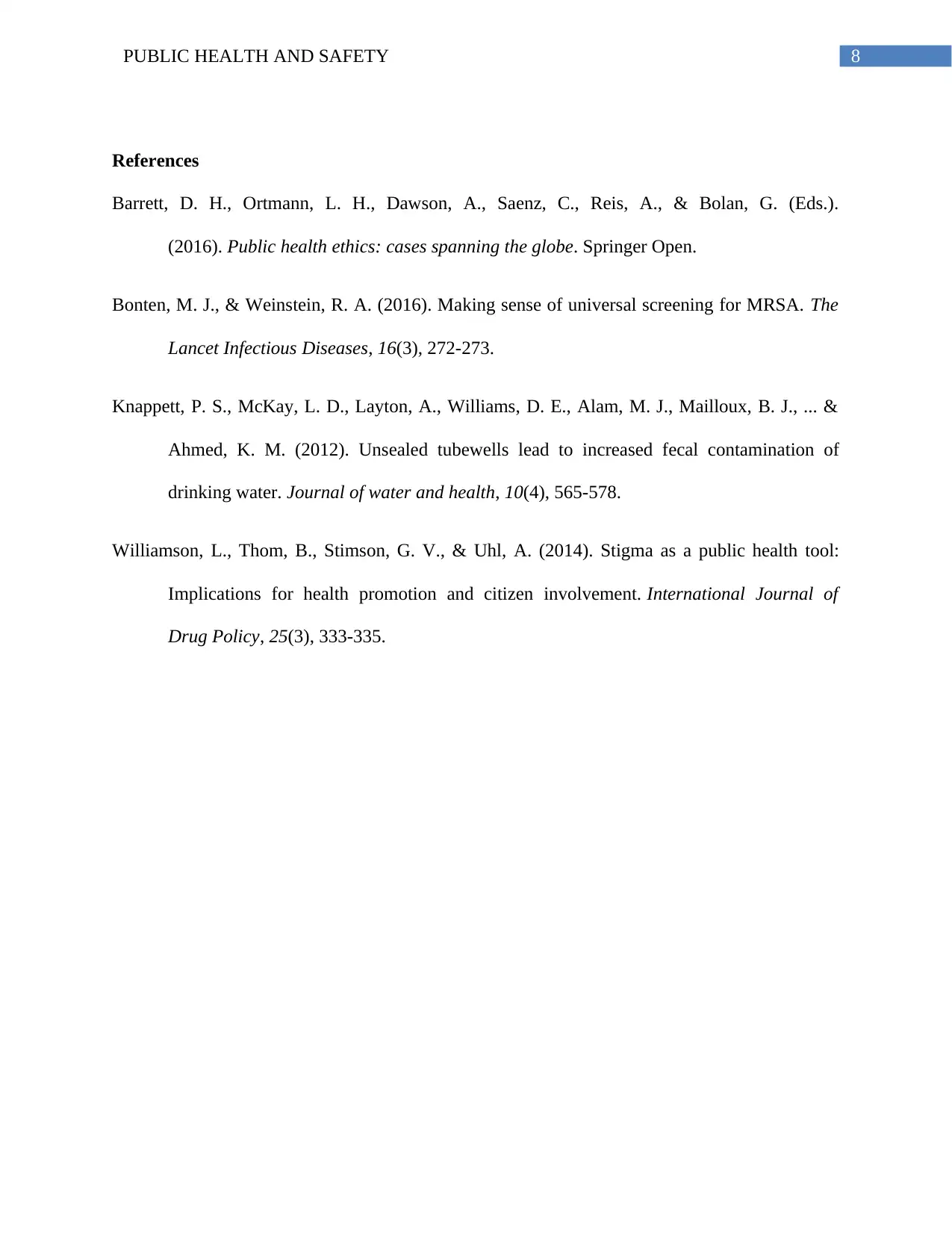
8PUBLIC HEALTH AND SAFETY
References
Barrett, D. H., Ortmann, L. H., Dawson, A., Saenz, C., Reis, A., & Bolan, G. (Eds.).
(2016). Public health ethics: cases spanning the globe. Springer Open.
Bonten, M. J., & Weinstein, R. A. (2016). Making sense of universal screening for MRSA. The
Lancet Infectious Diseases, 16(3), 272-273.
Knappett, P. S., McKay, L. D., Layton, A., Williams, D. E., Alam, M. J., Mailloux, B. J., ... &
Ahmed, K. M. (2012). Unsealed tubewells lead to increased fecal contamination of
drinking water. Journal of water and health, 10(4), 565-578.
Williamson, L., Thom, B., Stimson, G. V., & Uhl, A. (2014). Stigma as a public health tool:
Implications for health promotion and citizen involvement. International Journal of
Drug Policy, 25(3), 333-335.
References
Barrett, D. H., Ortmann, L. H., Dawson, A., Saenz, C., Reis, A., & Bolan, G. (Eds.).
(2016). Public health ethics: cases spanning the globe. Springer Open.
Bonten, M. J., & Weinstein, R. A. (2016). Making sense of universal screening for MRSA. The
Lancet Infectious Diseases, 16(3), 272-273.
Knappett, P. S., McKay, L. D., Layton, A., Williams, D. E., Alam, M. J., Mailloux, B. J., ... &
Ahmed, K. M. (2012). Unsealed tubewells lead to increased fecal contamination of
drinking water. Journal of water and health, 10(4), 565-578.
Williamson, L., Thom, B., Stimson, G. V., & Uhl, A. (2014). Stigma as a public health tool:
Implications for health promotion and citizen involvement. International Journal of
Drug Policy, 25(3), 333-335.
⊘ This is a preview!⊘
Do you want full access?
Subscribe today to unlock all pages.

Trusted by 1+ million students worldwide
1 out of 9
Related Documents
Your All-in-One AI-Powered Toolkit for Academic Success.
+13062052269
info@desklib.com
Available 24*7 on WhatsApp / Email
![[object Object]](/_next/static/media/star-bottom.7253800d.svg)
Unlock your academic potential
Copyright © 2020–2025 A2Z Services. All Rights Reserved. Developed and managed by ZUCOL.





